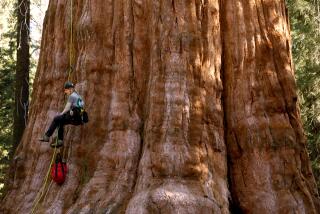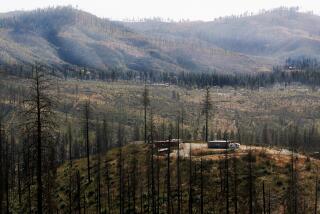Growing pains: The oldest trees on Earth ripped themselves apart, fossils show
- Share via
Scientists have discovered 374-million-year-old tree fossils from the dawn of Earth’s forests — and found that these strange plants literally had to rip themselves apart as they grew.
The fossils, described in the Proceedings of the National Academy of Sciences, shed light on the nature of ancient forests and the evolution of the Earth’s climate.
The Xinicaulis lignescens fossils, discovered in Xinjiang, China, are part of a group of species known as Cladoxylopsida — plants that have no known descendants but are thought to be related to the ancestors of today’s ferns and horsetails. They could grow about 10 to 12 meters tall and one meter wide at the base; their branches popped out of the top of the trunk, giving it a shape similar to today’s palms. These branches sprouted further, tinier appendages that were not yet true leaves.
Cladoxylopsida emerged in some of Earth’s earliest forests, during the Mid- to early Late Devonian period, around 393 million to 372 million years ago. There were bugs, and millipedes that may have munched on dead plant matter, but by and large these trees faced no major predators — vertebrate animals only just started getting a toehold on land in the late Devonian. These trees filled ancient forests by the millions.
Together with the other plants making up these early forest ecosystems, Cladoxylopsida helped transform Earth — shaping rivers, pulling carbon dioxide out of the atmosphere, perhaps increasing the planet’s humidity by gradually releasing water, and reducing the planet’s reflectivity, too.
“It’s just a fundamental change in the whole way that the Earth’s system works once you put large plants in forests onto a planet,” said study coauthor Christopher Berry, a paleobotanist at Cardiff University.
Understanding these long-gone trees could help scientists understand the evolution of Earth’s climate and biology during this pivotal time. But until now, the recovered fossils have usually been fallen, squashed trees, or natural sandstone casts of decomposing stumps. Neither gives much structural information.
“They tell you about shapes, they don’t tell you very much about growth and the anatomy,” Berry said.
Still, what little they could determine from these strange fossils, particularly from the stumps, had already caught their attention.
If you cut open a typical tree today, you’ll find that the xylem (the woody tissue that carries water up through the tree) grows outward from the center, forming concentric rings. But in the ancient specimens, the xylem grew in individual strands that clustered only in the outer five centimeters or so of the trunks, and were joined together by a complicated network of tinier strands. The center of the tree was hollow; all this activity took place in the thick woody ring around that empty space.
The structure was somewhat akin to the Eiffel Tower, Berry said: big, strong strands running down the outside corners, connected by a network of shorter bars — all surrounding a hollow middle.
“We couldn’t imagine how these things could possibly grow,” Berry said.
The two new fossil finds, an 8-centimeter specimen and a much larger 70-centimeter-wide trunk, shed some light on that mystery. Thanks to volcanic sediments, tiny grains of silica were able to penetrate deep into the trees’ tissues, preserving their structure on a cellular level — and allowing scientists to study it in unprecedented detail.
The researchers found that those individual xylem strands were actually growing like miniature trees, developing tiny ring after ring. What’s more, as the tree grew, the xylem fibers would actually tear themselves apart.
“In order to expand this trunk, all those interconnections have to slowly rip apart in order to accommodate the growth of the plant — and that was what we saw in the specimen,” Berry said. “As they were being pulled apart to make the tree bigger, they were also repairing themselves at the same time.”
As it grew, the strange tree’s trunk would bulge and ultimately collapse outward — forming a wider base in the process.
“This thing seems to be behaving in an organized way even though it’s so outrageous,” Berry said.
It’s unclear why these trees died out; it’s possible they were out-competed by new forms of trees that actually had leaves, and were ‘shaded out’ of the forest canopy. Perhaps a frosty period near the end of the Devonian killed them off. It’s also possible that the plants, which pulled down so much carbon dioxide from the air, might have taken out too much and starved themselves.
The next step, Berry said, is to probe how much carbon dioxide these plants really could have taken out of the air. That’s important because carbon dioxide isn’t just fuel for plants — it’s a greenhouse gas that traps heat.
“If we can work out how much carbon it absorbed over a certain amount of time,” Berry said, “then we’ll learn a little bit more about how capable it was of actually changing the atmosphere of the planet.”
Follow @aminawrite on Twitter for more science news and “like” Los Angeles Times Science & Health on Facebook.
MORE IN SCIENCE
What dolphin diets reveal about climate change’s effects off the California coast
With Obamacare, fewer Americans were uninsured when they were told they had cancer
Scientists engineer proteins that caused obese animals to lose weight and lower cholesterol







